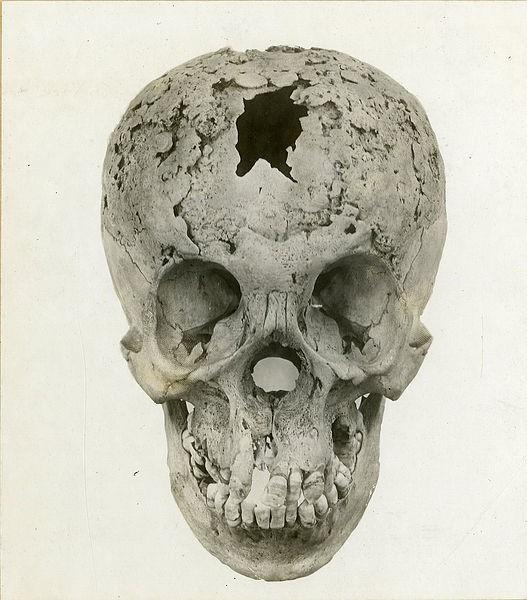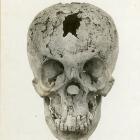
Skeletal manifestations of syphilis: This image from the early twentieth century shows characteristic alterations to the skull associated with tertiary syphilis. Erosions of the cranial bone, referred to as “caries sicca,” typically develop after several years, and are associated with the spread of infection to the brain and potentially with the development of neural symptoms. These lesions are considered to be diagnostic of syphilis, but are rarely seen in modern populations with access to antibiotic treatment.
Skeletal manifestations of syphilis: This image from the early twentieth century shows characteristic alterations to the skull associated with tertiary syphilis. Erosions of the cranial bone, referred to as “caries sicca,” typically develop after several years, and are associated with the spread of infection to the brain and potentially with the development of neural symptoms. These lesions are considered to be diagnostic of syphilis, but are rarely seen in modern populations with access to antibiotic treatment.
Otis Historical Archives National Museum of Health & Medicine. Photo taken by Reeve223. Click here to view Flickr source.
 This work is licensed under a Creative Commons Attribution 2.0 Generic License.
This work is licensed under a Creative Commons Attribution 2.0 Generic License.
In 1876, Joseph Jones published detailed descriptions of skeletal lesions in ancient human remains from Tennessee that he regarded as clear evidence of syphilis. Jones suggested that these may be the most ancient syphilitic lesions in the world, acknowledging that the major importance of his discovery was its contribution to the history of contagious disease, supporting the view that syphilis originated in the Americas. After Jones provided the first skeletal evidence of syphilis in archaeological skeletons from the New World, the following years saw many other claims of pre-Columbian skeletal evidence in the Americas.
Associations between the identification of venereal syphilis as an emerging disease and Columbus’s return to Europe after “discovering” the Americas led early on to the hypothesis that the disease arrived in Europe with Columbus. For paleopathologists, who study ancient diseases, the debate over the origin of syphilis is an important question with implications for the history of environmental interactions and the coevolution of human and bacterial populations. The three leading hypotheses propose that 1) treponemal diseases like syphilis either originated in the Americas and arrived with Columbus, 2) that they were already present in Europe but were not recognized as separate diseases until the end of the fifteenth century, or 3) they originated during the Paleolithic era and migrated along with all human populations. Much of the evidence for pre-Columbian skeletal cases of syphilis in both the Old and New Worlds, including some discovered by Jones, has been criticized due to difficulties in distinguishing different disease processes in ancient skeletal remains, the absence of reliable archaeological contextual information, and the incomplete nature of the skeletal record. However, since Jones’s discovery effectively brought paleopathology into this debate, human skeletal remains represent an important form of evidence for addressing the question of origins. While there is abundant evidence for some form of treponemal disease in the Americas before European contact, none of it clearly identifies venereal syphilis specifically. With increased analytical focus on European skeletal material, cases are increasingly being discovered in pre-Columbian Europe. Despite this, the idea of an American origin has persisted.

Christopher Columbus’s landing at San Salvador in 1492: This image shows a nineteenth-century European depiction of Columbus’s “discovery” of the Americas. Early European narratives around the “Columbian exchange” cast Europeans as the primary actors, and minimized the perspectives of Indigenous North Americans. This trend was also reflected in the early discourse surrounding the origins of syphilis.
Christopher Columbus’s landing at San Salvador in 1492: This image shows a nineteenth-century European depiction of Columbus’s “discovery” of the Americas. Early European narratives around the “Columbian exchange” cast Europeans as the primary actors, and minimized the perspectives of Indigenous North Americans. This trend was also reflected in the early discourse surrounding the origins of syphilis.
Chromolithograph by the Prang Educational Co., 1893.
 This work is licensed under a Creative Commons Public Domain Mark 1.0 License.
This work is licensed under a Creative Commons Public Domain Mark 1.0 License.
Discourse surrounding the origins of syphilis has a long history of blaming the “other,” the disease being first referred to as “the Neapolitan sickness” by the French and “the French sickness” by the Italians, before it was suggested by Diaz de Isla that “this sickness owes its origin and birth from time immemorial to the island which is now called Hispaniola” (in Quétel, 1990). Paleopathological discussions may have unwittingly contributed to this trend. Painful symptoms, connections between dirt and disease, and stigma from associations with immoral behavior have contributed to fears of physical and moral contagion. The association of this disease with Indigenous populations reinforced colonial structures in which marginalized groups were disadvantaged biologically and socially. In contextualizing the discussion of skeletal features of syphilis, many anthropologists pointed to other factors, including the virulence of syphilis in fifteenth-century Europe, as evidence for its novelty. More recent anthropological literature has introduced limited discussion of the potential impact of treponemal disease on Indigenous populations in the Americas. However, the absence of early accounts discussing the disease experience of Indigenous individuals makes it difficult to determine whether it may have also behaved as a novel or “emerging” disease in these populations, illustrating how the documentary evidence available might bias conceptions of who was most affected by venereal syphilis. This then affects how paleopathologists interpret skeletal evidence for this disease.
Framed in terms of gaining a scientific understanding of disease evolution and human-environment interactions, paleopathological debate over the origins of syphilis exists within a historical discourse rooted in racial thought, stereotyping, and medical stigmatization. Jones’s interest in 1876 in how the evidence of syphilis he observed in archaeological bones related to the origin of venereal syphilis continues to be an important focus of study for modern paleopathologists, partly due to the inability of current evidence to provide a definitive answer. Among all of the unanswerable problems in the history of infectious disease, why has this one become so important within scientific research? The debate surrounding the origins of syphilis takes place primarily in North American and western European academic circles, with limited involvement of lay participants or Indigenous scholars. Medical writing, which was influential in the development of paleopathology, continued to assume into the twentieth century that venereal diseases were endemic in Indigenous populations, although this was not supported by statistical evidence. Current paleopathological discourse around the origins of syphilis frames itself as scientific and objective and avoids placing explicit blame on any group of people. However, failing to acknowledge the origins of this question, and the clear implications that it had for Indigenous groups as recently as the twentieth century, ignores the fact that unacknowledged preconceptions about Indigenous bodies as sources of contagion may subconsciously play into the staying power of the idea that syphilis originated in the Americas, despite the existence of evidence to the contrary. One key reason that research must move past this is the need to recognize that the nature of these questions hails from a discursive history characterized by moralizing and racial thought.
How to cite
Lockau, Laura. “A Question of Origins: Skeletal Evidence for the History Venereal Syphilis.” Environment & Society Portal, Arcadia (Summer 2017), no. 27. Rachel Carson Center for Environment and Society. doi.org/10.5282/rcc/7952 (link is external).
ISSN 2199-3408
Environment & Society Portal, Arcadia
 This work is licensed under a Creative Commons Attribution 4.0 International License.
This work is licensed under a Creative Commons Attribution 4.0 International License.
2017 Laura Lockau
This refers only to the text and does not include any image rights.
Please click on an image to view its individual rights status.
- Crosby, Alfred. The Colombian Exchange: Biological and Cultural Consequences of 1492. Westport, CT: Praeger Publishers, 2003.
- Baker, Brenda J., and George J. Armelagos. “The Origin and Antiquity of Syphilis: Paleopathological Diagnosis and Interpretation.” Current Anthropology 29 (1998): 703–37.
- Jones, Joseph. “Explorations of the Aboriginal Remains of Tennessee.” Smithsonian Contributions to Knowledge 22 (1876): 1–171.
- Powell, Mary Lucas, and Della Collins Cook. The Myth of Syphilis: The Natural History of Treponematosis in North America. Gainesville: University Press of Florida, 2005.
- Quétel, Claude. History of Syphilis. Baltimore: The Johns Hopkins University Press, 1990.
- Stannard, David E. American Holocaust: Columbus and the Conquest of the New World. New York: Oxford University Press, 1992.
- Washer, Peter. Emerging Infectious Diseases and Society. New York: Palgrave Macmillan, 2010.








